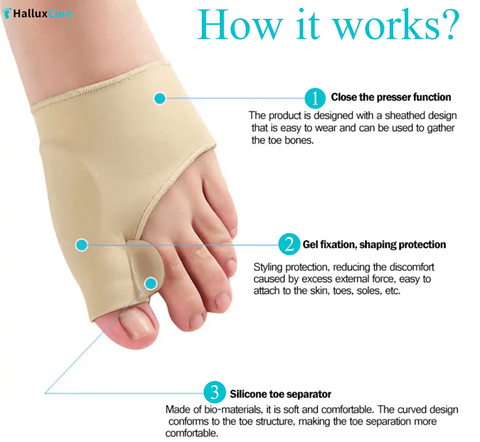Why You Should See a Podiatrist for Pinky Toe Pain and How to Protect Your Feet
If you’ve ever experienced pinky toe discomfort or noticed bruising and strain around your toes, you’re not alone. Issues like these are often caused by improper footwear, poor foot mechanics, or even underlying structural problems in the foot. While quick remedies like icing and elevating can provide temporary relief, there’s usually a deeper issue at play—such as a malformed joint—that requires professional attention. This is why seeing a podiatrist is a critical first step in addressing foot pain effectively.
In this blog post, we’ll delve into the essentials of foot health, what you can do to minimize discomfort, and why proactive care is key. Plus, we’ll explore how tools like the Orthopedic Bunion Pain Relief and Correction Sleeve can provide day-to-day relief.
---Understanding Pinky Toe Pain and Bruising
The Common Culprits
Your pinky toe may seem small, but it plays a significant role in maintaining balance and supporting weight. Pain or bruising often arises for these reasons:
- Ill-Fitting Shoes: Tight footwear, especially those that pinch your pinky toe, can lead to bruising, irritation, and even deformities over time.
- Toe Misalignment: A malformed or misaligned joint could be the root cause of chronic pain, even if symptoms seem minor at first.
- Repetitive Strain: Activities like running, walking, or prolonged standing can exacerbate strain on the toes.
Why Proper Footwear Matters
Footwear that allows your toes to splay naturally—meaning they can spread out without touching the sides of the shoe—is essential for healthy foot mechanics. Tight shoes can not only cause bruising but also lead to long-term issues like bunions or hammertoes.
---Quick Relief Tips for Pinky Toe Pain
While you wait to see a podiatrist, here are some simple, effective ways to manage discomfort:
- Ice and Elevate: Apply ice to the affected area for 15-20 minutes and keep your foot elevated to reduce swelling.
- Choose Better Shoes: Opt for wide-toed, supportive footwear that doesn’t compress your pinky toe.
- Use Orthopedic Sleeves: Consider a bunion correction sleeve to ease strain and promote proper alignment.
4.9 ⭐⭐⭐⭐⭐ ( 1843 reviews )
---
Addressing the Root Cause: Why You Need a Podiatrist
If your pain persists or worsens, it’s time to consult a podiatrist. Here’s why:
- Accurate Diagnosis: A professional evaluation will determine whether your pain stems from a misaligned joint, bunion, or another underlying issue.
- Customized Treatment: Podiatrists can recommend tailored solutions—such as orthotics, physical therapy, or even surgical options if necessary.
- Preventative Care: Early intervention can prevent small problems from escalating into chronic conditions.
The Role of Orthopedic Aids in Foot Health
Orthopedic aids like bunion correction sleeves are invaluable for managing foot pain. These sleeves not only provide padding and support but also help gently realign your toes over time.
If you’re looking for relief from bunion pain, consider using the Orthopedic Bunion Pain Relief & Correction Sleeve , which provides support and helps to alleviate discomfort.
For additional protection, the Tailor's Bunion Bunionette Pain Relief Protection Sleeves are designed to offer comfort and protection for bunionette pain.
To nourish and soothe the skin around bunions, as well as to promote healthy hair, consider the Jamaica Black Castor Oil Soothing Oil . Known for its moisturizing and anti-inflammatory properties, it helps alleviate discomfort around bunions and supports hair growth and scalp health.
---Final Thoughts
Your feet are the foundation of your body, and taking care of them is essential for overall health and mobility. Whether it’s as simple as switching to better footwear or as involved as seeking professional care, small changes can make a big difference.
Have you ever struggled with toe pain or bunions? What strategies have worked for you? Share your thoughts and tips in the comments below—let’s keep the conversation going!




